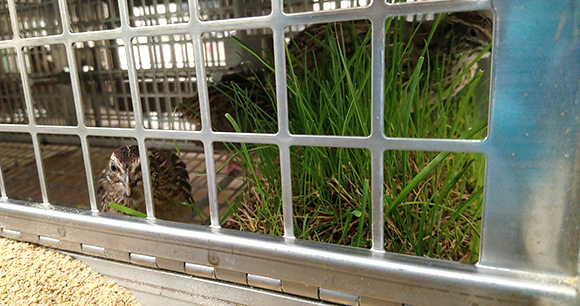by Rachel Dennis, PhD, University of Maryland
Barren colony cages are often used for housing of breeding and research quail, especially within laboratory animal housing systems. These systems provide for ease of care and the maintenance of strict laboratory hygiene requirements, but create serious welfare concerns and limit environmental enrichment options. Quail maintained in barren environments have been shown to exhibit high-stress-related behaviors, reduced immunocompetence, and increased injury and mortality due to excessive matings and agonistic interactions. In addition to creating concerns over poor animal well-being, these environments may compromise research results by oversampling high-stressed and immunocompromised individuals.

In the present study, funded by an AWI Refinement Grant, we investigated the impacts of six environmental enrichments that were primarily either protective (acrylic hut, natural grass, or hanging synthetic leaves/brush) or stimulatory (foraging mat, mirror, or feeder toy) on colony-housed Japanese quail. We hypothesized that protective enrichments would have a greater impact on behavioral and physiological measures of well-being. We included natural grass (see photo above) due to its use in nature by wild Japanese quail. However, the difficulties of maintaining grass in a laboratory setting make it challenging in certain circumstances that require high degrees of cleanliness and sterility.
Our results showed that all enrichments used in this study improved welfare measures compared to a barren environment. Protective enrichments reduced incidents of agonistic interactions and matings, while having no impact on rates of egg fertilization. Specifically, grass and hut enrichment lowered frequency of mounting, feather pecking, and vigilance behaviors.
Quail most frequently interacted with the grass enrichment, including by pecking at the grass, sitting in the grass, and laying eggs inside the enrichment area. Protective huts provided the second-greatest increase in welfare measures. Quail provided with huts increased sitting behavior, gained more weight, and laid more eggs than control birds. Fecal corticosterone levels (a noninvasive measure of stress) were reduced in both grass- and hut-enriched birds. Hanging leaves also provided an improvement in welfare measures compared to a barren environment, but to a lesser degree than grass or huts.
Stimulatory enrichments also improved overall well-being by reducing feather pecking and improving feather condition scores. All enrichments increased sitting behavior compared to quail in barren environments. Corticosterone levels were reduced in quail provided with foraging mats; however, no difference in corticosterone was found in birds provided hanging leaves, mirrors, or feeder toys.
In conclusion, these results highlight the importance of environmental enrichments in colony-caged Japanese quail. Natural grass appears to be the most beneficial and is strongly recommended whenever possible. Our study further suggests that, at minimum, protective huts should be provided. They are easy to maintain and hygienic, improve growth and production measures, and significantly enhance the well-being of the birds.